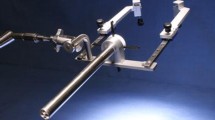Abstract
Background
Though single-incision laparoscopic surgery (SILS) can reduce operative scarring and facilitates postoperative recovery, it does have some limitations, such as reduction in instrument working, difficulty in triangulation, and collision of instruments. To overcome these limitations, development of new instruments is needed. The aim of this study is to evaluate the feasibility and safety of a magnetic anchoring system in performing SILS ileocecectomy.
Methods
Experiments were performed in a living dog model. Five dogs (26.3–29.2 kg) underwent ileocecectomy using a multichannel single port (OCTO port; Darim, Seoul, Korea). The port was inserted at the umbilicus and maintained a CO2 pneumoperitoneum. Two magnet-fixated vascular clips were attached to the colon using an endoclip applicator, and it was held together across the abdominal wall by using an external handheld magnet. The cecum was then retracted in an upward direction by moving the external handheld magnet, and the mesocolon was dissected with Ultracision®. Extracorporeal functional end-to-end anastomosis was done using a linear stapler. All animals survived during the observational period of 2 weeks, and then re-exploration was performed under general anesthesia for evaluation of intra-abdominal healing and complications.
Results
Mean operation time was 70 min (range 55–100 min), with each subsequent case taking less time. The magnetic anchoring system was effective in achieving adequate exposure in all cases. All animals survived and convalesced normally without evidence of clinical complication during the observation period. At re-exploration, all anastomoses were completely healed and there were no complications such as abscess, bleeding or organ injury.
Conclusions
SILS ileocecectomy using a magnetic anchoring system was safe and effective in a dog model. The development of magnetic anchoring systems may be beneficial for overcoming the limitations of SILS.





Similar content being viewed by others
References
Leggett PL, Churchman-Winn R, Miller G (2000) Minimizing ports to improve laparoscopic cholecystectomy. Surg Endosc 14:32–36
Cerci C, Tarhan OR, Barut I, Bulbul M (2007) Three-port versus four-port laparoscopic cholecystectomy. Hepatogastroenterology 54:15–16
ASGE/SAGES Working Group on Natural Orifice Translumenal Endoscopic Surgery White Paper October 2005 (2006) Gastrointest Endosc 63:199–203
Marescaux J, Dallemagne B, Perretta S, Wattiez A, Mutter D, Coumaros D (2007) Surgery without scars: report of transluminal cholecystectomy in a human being. Arch Surg 142:823–826
Pelosi MA, Pelosi MA III (1992) Laparoscopic supracervical hysterectomy using a single-umbilical puncture (mini-laparoscopy). J Reprod Med 37:777–784
Kaouk JH, Goel RK, White MA, White WM, Autorino R, Haber GP, Campbell SC (2010) Laparoendoscopic single-site radical cystectomy and pelvic lymph node dissection: initial experience and 2-year follow-up. Urology 76:857–861
Piskun G, Rajpal S (1999) Transumbilical laparoscopic cholecystectomy utilizes no incisions outside the umbilicus. J Laparoendosc Adv Surg Tech A 9:361–364
Varshney S, Sewkani A, Vyas S, Sharma S, Kapoor S, Naik S, Purohit D (2007) Single-port transumbilical laparoscopic-assisted appendectomy. Indian J Gastroenterol 26:192
Bucher P, Pugin F, Morel P (2008) Single port access laparoscopic right hemicolectomy. Int J Colorectal Dis 23:1013–1016
Kume M, Miyazawa H, Iwasaki W, Abe F, Uchinami H, Yamamoto Y (2008) The use of magnetic anchors in the bowel lumen for laparoscopic anterior resection of rectosigmoid colon in pigs: with video. World J Surg 32:2425–2428
Park S, Bergs RA, Eberhart R, Baker L, Fernandez R, Cadeddu JA (2007) Trocar-less instrumentation for laparoscopy: magnetic positioning of intra-abdominal camera and retractor. Ann Surg 245:379–384
Zeltser IS, Bergs R, Fernandez R, Baker L, Eberhart R, Cadeddu JA (2007) Single trocar laparoscopic nephrectomy using magnetic anchoring and guidance system in the porcine model. J Urol 178:288–291
Acknowledgments
This work was supported by Samsung Biomedical Research Institute grant SBRI C-A9-237-1 (Seoul, Korea).
Conflict of interest
Authors Yong Beom Cho, Chan Ho Park, Hee Cheol Kim, Seong Hyeon Yun, Woo Yong Lee, and Ho-Kyung Chun have no conflicts of interest or financial ties to disclose.
Author information
Authors and Affiliations
Corresponding author
Additional information
Yong Beom Cho and Chan Ho Park contributed equally to this work.
Rights and permissions
About this article
Cite this article
Cho, Y.B., Park, C.H., Kim, H.C. et al. Single-incision laparoscopic surgery in a survival animal model using a transabdominal magnetic anchoring system. Surg Endosc 25, 3934–3938 (2011). https://doi.org/10.1007/s00464-011-1809-8
Received:
Accepted:
Published:
Issue Date:
DOI: https://doi.org/10.1007/s00464-011-1809-8




